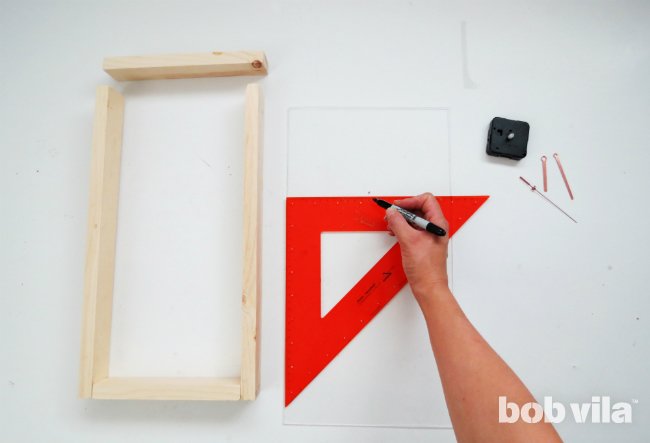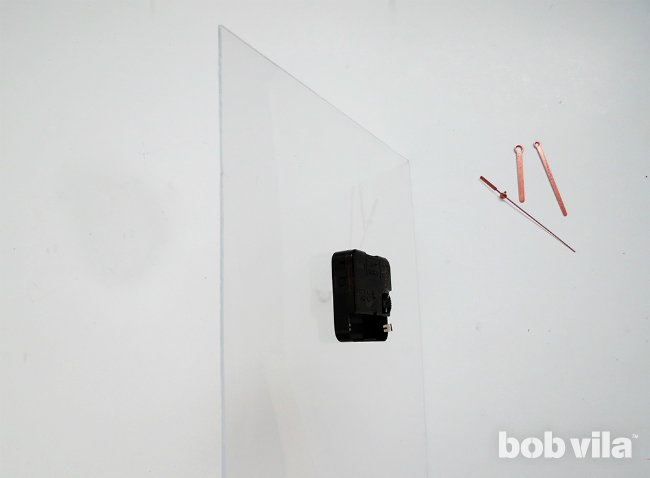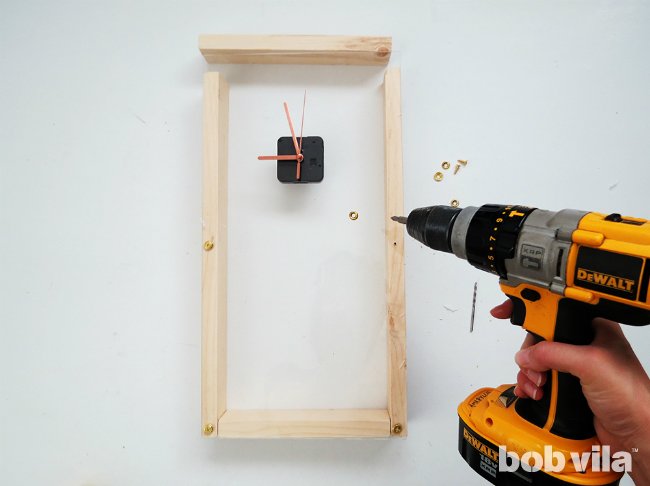

We may earn revenue from the products available on this page and participate in affiliate programs. Learn More ›
Clocks may be less a necessity than they were in the days before cell phones remained attached to consumers’ hips and high-tech wearables resurged interest in the wristwatch—but that doesn’t make the tabletop fixtures any less functional. There’s some relief in knowing you don’t need to be tethered to today’s technology 24 hours a day thanks to usefulness of an old-fashioned home staple. Don’t get us wrong: This particular modern acrylic design is nothing quite like what you’d see on your grandmother’s shelves. Instead, it merges the functionality of a timekeeper with the ability to house keepsakes—or, in our case, fake succulents and cacti! No matter how you plan to fill it, read on for how to make a clock worthy of display on your bookshelf.

MATERIALS AND TOOLS
– Cheap clock
– Screwdriver
– 3/16-inch thick acrylic sheet (18″ × 24″)
– Ruler
– Permanent marker
– Utility knife
– Clamp
– 120-grit sandpaper
– 1×2 lumber (5 ft.)
– Saw (optional)
– Wood glue
– Hammer
– 1-inch nails (4)
– Scrap wood
– Fake succulents or air plants
– Black gravel (1 pound)
– White gravel (1 pound)
– Drill
– Silicone glue
– ½-inch brass screws (12)
– Brass washers (12)

STEP 1
First, disassemble the housing of any old cheap plastic clock. (Check the dollar store for a steal—it doesn’t matter what the clock looks like now because, to make a clock that contains a terrarium, all you really need is the clock assembly and the hands that spin.) Unscrew the back of the clock to separate its pieces; then, once open, gently pull the clock hands off of the face of the clock. This will allow you to remove the lock assembly from behind the face. Keep the pieces on the side, you will use them later.
If you’d rather bypass this step entirely, you can skip the stop at the dollar store and pick up a clock kit for a reasonable price online or at your local home improvement center.

STEP 2
You’ll make the front and the back of this DIY clock from your 3/16-inch acrylic sheet. Turn the sheet so that its longer edge is horizontal, then measure and mark to cut it at 9 inches and 18 inches using permanent marker.
Now, place the ruler vertically at the first mark, hold it firmly as a guide, and score along it several times using the box cutter. It will take as many as 10 or 12 passes until you have made a deep groove in the acrylic; then, flip over and repeat at this same mark on the opposite side. Move the acrylic so that the scored groove lines up with the edge of your work surface, and clamp half of the acrylic steady to the table in place while you press down on the portion that extends to snap it off.
Repeat the process with the second mark at 18 inches, and you should be left with two 9-inch by 18-inch rectangles.
If you intend to have the contents of the DIY clock be living air plants (remember, we’re using fake succulents because there’s not adequate drainage for real ones) or would like to be able to treat it as a shadowbox collection you can add to over time, one rectangle should be a little shorter. Score and cut the second rectangle down to 9 inches by 15 inches in order to give you enough room for misting your plants or dropping in beer bottle caps, wine corks, spare change, or the likes.

STEP 3
Buff out the imperfections along all edges of the two acrylic rectangles with a 120- or 150-grit sandpaper.

STEP 4
Cut your 1×2 lumber (or ask the home improvement center where you purchased your wood to do so) into four pieces to build a frame that matches the dimensions of your acrylic pieces. You will need two 17-1/4-inch lengths for the sides, one 7-½-inch lengths for the bottom, and one 9-inch length for the top.
Sand all the pieces to remove splinters. If you like, you can stain or paint the wood before proceeding.

STEP 5
Begin to make a clock’s structure by assembling the bottom and sides into a U-shape, keeping the 1-½-inch edge of each 1×2 facing out (remember, a 2×2 isn’t exactly 2 inches by 2 inches). First, apply wood glue to each end of the 7-½-inch cut; then, press them to the bottoms of the two 17-1/4-inch sides so that you create a U-shape. Hammer two 1-inch nails through each side into the bottom of the frame. For now, the top piece remains unaffixed.

STEP 6
Take one of the acrylic rectangles (if yours are different sizes, choose the one that’s 9 inches by 18 inches) and use permanent marker to identify the point where you want the center of the clock to be. Don’t forget to your ruler: It should be in the exact middle from the sides (4-½ inches in) and at least 5 inches from the top of the sheet.

STEP 7
Place a piece of scrap wood beneath the acrylic, and, exactly where the mark is, carefully drill a hole into the sheet. Note: The drill bit has to be the same dimension as the clock axis so that it can pass through the acrylic and allow the clock hands to pass on the opposite side. (We used a 7/32 drill bit, but the best size may vary depending on your clock model.)
Use a corner of your sandpaper to carefully sand any loose plastic flakes away from the hole without scratching up too much of the acrylic.

STEP 8
Pass the axis of the clock through the acrylic sheet, then apply a dot of silicone glue to hold the clock case to the acrylic sheet. Attach the clock hands and battery. Once the clock is up and running, set your clock to the correct time.

STEP 9
Prepare to attach the plain acrylic sheet (the one minus the clock) to the wood frame. First, fix the acrylic so that its bottom corners align with the bottom corners of the half-assembled frame. (Remember: If you’re creating a slim opening in the back of your DIY clock, this will be a shorter 9-inch by 15-inch piece of acrylic that does not meet the top.) Starting in the lower left corner, drill through the acrylic and into the frame, thread a screw with a washer, and twist the fasteners to hold the sheet to the wood. Repeat again at the bottom right corner and once in the center of each side.
Once the back is fixed, flip the frame and screw the second acrylic sheet (the one with the clock) onto its front. As you did for the back, pre-drill and fasten the front sheet using a screw and washer in the lower corners and side centers.

STEP 10
Stand your clock and start filling it through the top. If you’re going to treat it like a terrarium, layer your gravel—first the black stones, then the white stones. Pull the fake succulents out of miniature planters, and “root” them into the gravel.

STEP 11
Once you are satisfied, place the last wood piece on top to close the clock. Don’t use glue or nails here, so that you can more easily open the clock to change the battery down the road. Instead, pre-drill through the top corners of the front acrylic sheet (with the clock) and wood, and twist in a screw and washer. Repeat on the back if your acrylic extends all the way to the top.
That’s a wrap! When finished following this DIY lesson on how to make a clock, designate a prime spot on the shelf for this good-looking timekeeper.


Ama is a DIY addict and the creative mind behind Ohoh Blog. She likes home decor, lighting, and furniture projects that may involve painting, sewing, drilling…no matter the technique! Whatever she has on hand is inspiration to create, and fodder for her serious addiction to upcycling.
